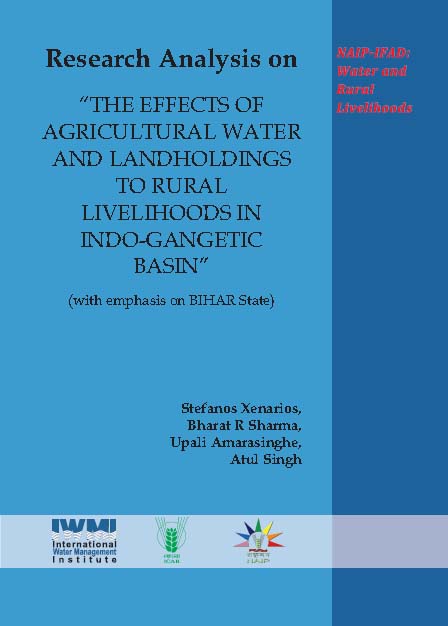/regions/bihar
Bihar
The effects of agricultural water and landholdings to rural livelihoods in Indo-Gangetic basin – Research analysis by IWMI and ICAR with an emphasis on Bihar
Posted on 18 Apr, 2011 11:56 PM The current research analysis by International Water Management Institute (IWMI) in cooperation with ICAR Resear
The current research analysis by International Water Management Institute (IWMI) in cooperation with ICAR Resear
Hard work, no pay - Summer jobs off the beaten track - Opportunities for working on NREGA and ICDS schemes in Araria, Bihar
Posted on 14 Apr, 2011 04:44 PMForwarded to the portal by: Kamayani Swami and Ashish Ranjan for Jan Jagaran Shakti Sangathan
Do you support the National Rural Employment Guarantee Act (NREGA) and the Integrated Child Development Scheme (ICDS)? Then why not give some of your time to help make it work?
Evaluation of sanitation and wastewater treatment technologies: Case studies from India
Posted on 15 Nov, 2010 11:52 PMThe sanitation systems studied are spread across the country. The study goes to Pratapnagar in Bihar to evaluate the success of the septic tank to Asalthpur in Uttar Pradesh to study the Ecosan (UDDT) toilet. Other locations in India include Maharashtra, Gujarat, Kerala.
Waterlogged area mapping and hydrological data analysis of Mokama tal area – A research report by National Institute of Hydrology
Posted on 27 Jul, 2010 11:42 PMThe report presents waterlogged area mapping and hydrological data analysis of Mokama tal area of Bihar. The drainage problems of the agriculture land use are basically associated with the stagnation of runoff and the rise of the water table. Generally, the runoff stagnation is a result of intense rain, which produces excessive runoff for which the existing drainage capacity is not adequate or outlet conditions are not favorable. The rise of water table beyond a critical limit or surface ponding results in waterlogging conditions.
Characteristics of short interval rainfall for Punpun basin in Bihar – A research report by National Institute of Hydrology
Posted on 24 Jul, 2010 09:50 PMIn this study, an attempt has been made to study the characteristics of short interval rainfall data of the Punpun river basin lying in Bihar-Jharkhand, which has been identified as the representative basin for the NIH- Centre for Flood Management Studies, Patna. The estimation of flood peaks for small catchments is required for water resources planning, flood forecasting, design of various drainage systems, flood control and design of hydraulic structures.
Estimation of soil erosion and sediment yield in Karso catchment of Barakar basin in Jharkhand using ANSWERS model - A research report by National Institute of Hydrology
Posted on 24 Jul, 2010 10:21 AMThe report presents an estimation of soil erosion and sediment yield for the Karso catchment of Barakar basin in Jharkhand using ANSWERS model. Quantitative assessments of runoff and soil erosion are needed for proper management of land and water resources.
Development of conjunctive use model for lower Gandak basin – A Research Report by National Institute of Hydrology
Posted on 19 Jul, 2010 11:02 PMThe study attempts to develop a conjunctive use model involving judicious use of surface and groundwater for the Habibpur region of Gandak command in Bihar. The area is characterized by insufficient surface water during rabi and summer seasons and excess surface water in the kharif season.
Flood estimation by GIS based GIUH approach for Ajay basin up to Sarath gauging site of South Bihar – A research report by the National Institute of Hydrology
Posted on 13 Jul, 2010 11:49 PMIn this study, the mathematical model developed at the National Institute of Hydrology for estimation of the Clark model parameters using the geomorphological characteristics of an ungauged basin has been applied for simulation of the direct surface runoff (DSRO) hydrographs of the Ajay basin up to the Sarath gauging site of South Bihar.
Soil erosion and sediment yield modeling using kinematic wave in GIS environment – A research report by National Institute of Hydrology
Posted on 30 Jun, 2010 10:37 PMThe study uses GIS techniques for spatial discretization of the Karso catchment into time-area segments to be used in numerical solutions of the governing differential equations for rainfall-runoff-erosion process. Various thematic layers such as soil, land use, slope, flow direction and Digital Elevation Model (DEM) were generated for the catchment using various tools available in GIS. These thematic layers were further utilized to generate attribute information such as Manning’s n, USLE K and C parameters for use in the rainfall-runoff-soil erosion model.
Estimation of soil erosion and sediment yield using GIS in Nagwa watershed, Bihar – A research report by National Institute of Hydrology
Posted on 29 Jun, 2010 08:13 PMThe study demonstrates Geographic Information Systems (GIS) based methodology for identification of sediment source areas and prediction of storm sediment yield for small watersheds. The Nagwa watershed in Bihar was discretized in to 50m grid cells using Integrated Land and Water Information Systems (ILWIS) GIS package, and unique drainage directions were obtained using GIS analysis. Also, a threshold channel network was generated from Digital Elevation Model (DEM) of the watershed. Actual observed drainage and generated drainage networks were superimposed and were found identical.